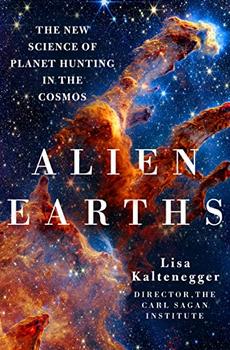Summary | Excerpt | Reviews | Beyond the Book | Readalikes | Genres & Themes | Author Bio

The New Science of Planet Hunting in the Cosmos
by Lisa Kaltenegger
The vastness of space is only occasionally dotted with stars, with enormous distances between them. For me, these become much easier to imagine when I shrink them in my mind to the scale of everyday objects. Let's reduce our solar system—from the Sun to the outermost planet, Neptune—to the size of a cookie with a diameter of about two inches. How far away do you think the Sun's closest neighbor is? Two cookies away? Five? One hundred? It is much farther than that—nearly nine thousand cookies. Or, on the same cookie scale, about four football fields away. To chart the distances between stars in the cosmos, you need larger units than miles or kilometers, or cookies. Using a light-year as our cosmic yardstick makes it easier to comprehend these unimaginable expanses.
Light travels at an incredible speed: about 190,000 miles (~ 300,000 km) per second, or an astonishing 6 trillion miles (~ 9 trillion km) per year. It takes light only about one second to travel between the Earth and the Moon, about 240,000 miles (~ 380,000 km), and a mere eight minutes to cross the distance from the Earth to the Sun. In those eight minutes, light travels a relatively tiny cosmic distance of 93 million miles (~ 150 million km). The closest neighboring star to our Sun is Proxima Centauri, at an enormous distance of 25 trillion miles (~ 40 trillion km) away. Even light takes about four years to travel that vast distance. So as well as conveying distance, a light-year scale tells us how long it takes for light to make the trip. We humans are starting to venture into our solar system, but these distances are small compared to the spaces separating the stars.
Our galaxy is about one hundred thousand light-years across. If a civilization had the means to navigate at even 10 percent of the speed of light, it could, in principle, cross the galaxy in about a million years. In principle. Most of the travel time would be spent voyaging through empty space: even a trip between our Sun and its closest stellar neighbor would take decades. Most of the trip would be endlessly boring because the distances between stars are so vast. And moving at such breakneck tempo would be exceedingly dangerous, since, running into even a small grain of interstellar material at that speed could result in disaster for the spacecraft and everyone on it. A million years is a long time compared to a human lifetime, or even to humanity's evolution, but some stars and their planets are much older than ours. If older civilizations exist, our galaxy might already contain their outposts, relics, or signals indicating advanced technology. But we have not encountered any yet. (Nor have we traveled very far from home.) So, as my students often suggest, do we lack alien visitors because the distances between habitable worlds are just too vast to navigate?
Let's leave reality and get inspired by solutions presented by science fiction. While I personally love the idea of moving at faster-than-light speed, like the fictional starship Enterprise in the sci-fi Star Trek franchise, warp speed is most likely impossible to achieve, even in the future, because our universe is bound by the laws of physics. Based on everything we know, faster-than-light travel is a barrier we cannot cross. In an alternative visually stunning vision imagined in Luc Besson's 2017 film Valerian and the City of a Thousand Planets, through complex but possible marvels of technology, enormous space stations navigate the cosmos while their passengers experience the wonders of the universe. The fictional spaceship contains a vast metropolis that is home to species from a myriad of alien worlds.
For now these possibilities to cross the galaxy are beyond us. But perhaps there is another way aliens might reach us. Since light travels at an astonishing speed, that means messages encoded in radio signal can travel fast. Often, the word "light" is used only to describe the narrow range of electromagnetic radiation that our eyes have evolved to see. Imagine that you are holding a prism, a wedge of glass, and you pass a beam of white sunlight through it. A brilliant cascade of colors emerges ranging from deep reds to vibrant violets: the spectrum of visible light. Yet, what you see is but a minute portion of the full range of electromagnetic radiation that extends far beyond our human sight, into the infrared and ultraviolet, radio waves and gamma rays, all different notes in this grand cosmic composition of light.
Excerpted from Alien Earths by Lisa Kaltenegger. Copyright © 2024 by Lisa Kaltenegger. Excerpted by permission of St. Martin's Press. All rights reserved. No part of this excerpt may be reproduced or reprinted without permission in writing from the publisher.
Your guide toexceptional books
BookBrowse seeks out and recommends the best in contemporary fiction and nonfiction—books that not only engage and entertain but also deepen our understanding of ourselves and the world around us.